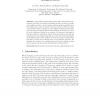Free Online Productivity Tools
i2Speak
i2Symbol
i2OCR
iTex2Img
iWeb2Print
iWeb2Shot
i2Type
iPdf2Split
iPdf2Merge
i2Bopomofo
i2Arabic
i2Style
i2Image
i2PDF
iLatex2Rtf
Sci2ools
CIE
2009
Springer
2009
Springer
Computational Heuristics for Simplifying a Biological Model
Abstract. Computational biomodelers adopt either of the following approaches: build rich, as complete as possible models in an effort to obtain very realistic models, or on the contrary, build as simple as possible models focusing only on the core aspects of the process, in an effort to obtain a model that is easier to analyze, fit, and validate. When the latter strategy is adopted, the aspects that are left outside the models are very often up to the subjective options of the modeler. We discuss in this paper a heuristic method to simplify an already fit model in such a way that the numerical fit to the experimental data is not lost. We focus in particular on eliminating some of the variables of the model and the reactions they take part in, while also modifying some of the remaining reactions. We illustrate the method on a computational model for the eukaryotic heat shock response. We also discuss the limitations of this method.
| Added | 26 May 2010 |
| Updated | 26 May 2010 |
| Type | Conference |
| Year | 2009 |
| Where | CIE |
| Authors | Ion Petre, Andrzej Mizera, Ralph-Johan Back |
Comments (0)

